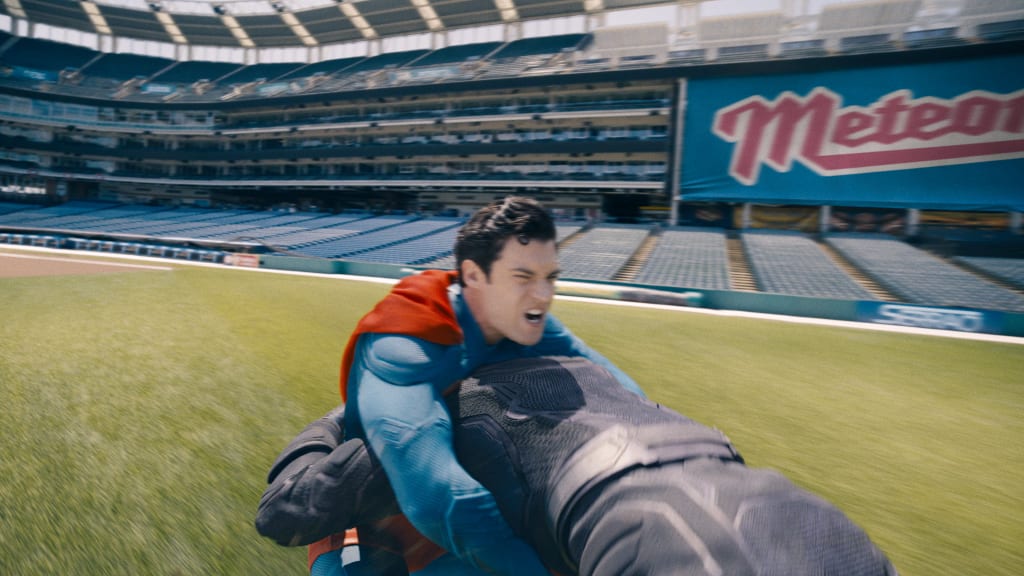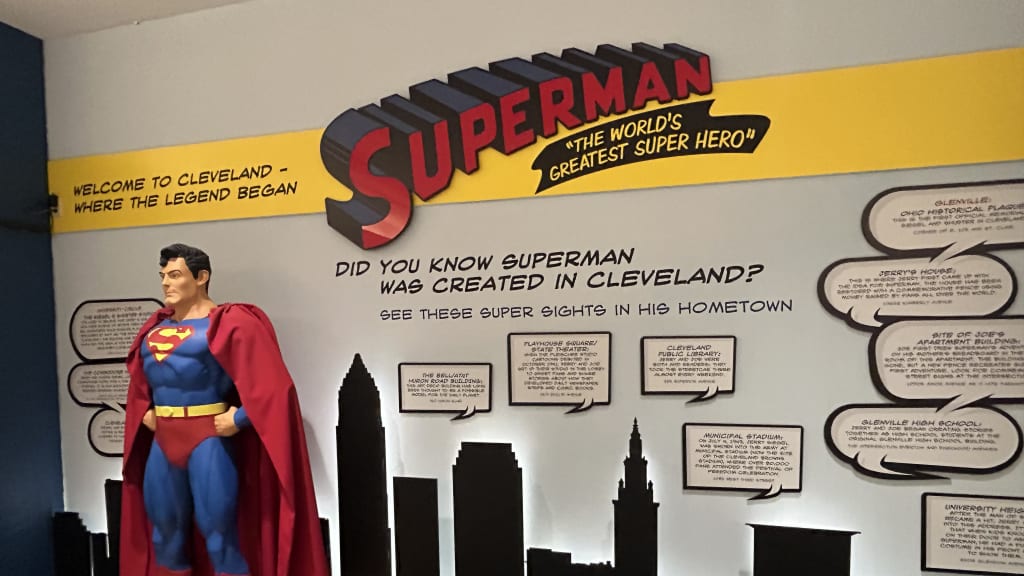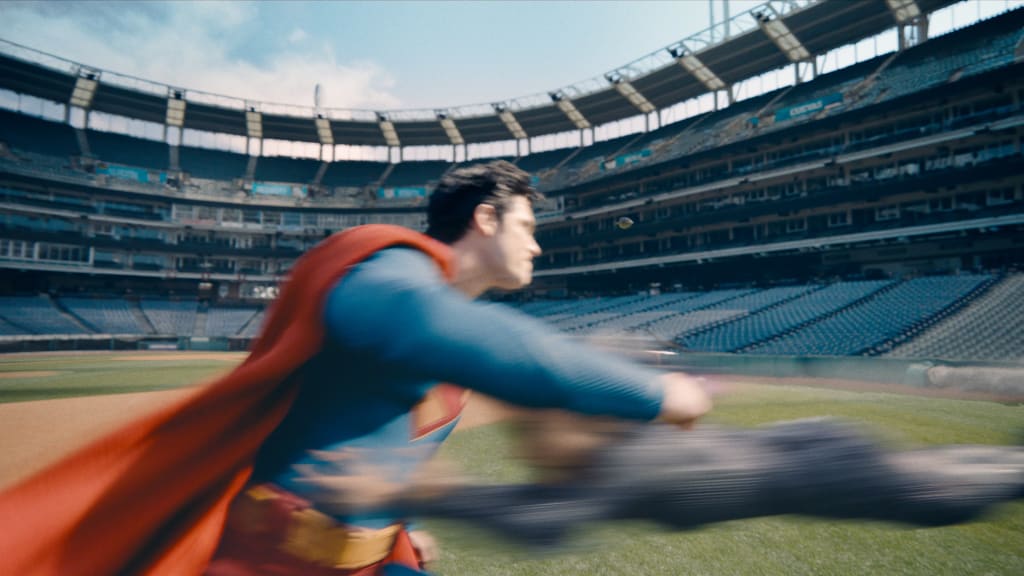
This story was excerpted from Tim Stebbins' Guardians Beat newsletter. To read the full newsletter, click here. And subscribe to get it regularly in your inbox.
CLEVELAND -- Superman is fighting for his reputation and life. Lex Luthor has manipulated the public to sway opinion against the Man of Steel, and dispatched Ultraman and The Engineer to defeat him.
A battle breaks out in Metropolis. Superman crashes through a massive light fixture and onto a grass field. Amid a skirmish, The Engineer knocks him to the ground, leaving a divot behind a dirt mound. As hope begins to wane, with Superman seemingly overmatched, he bursts into the sky as his foes give pursuit.
This is a climactic scene in this summer’s biggest blockbuster film, and it all begins at … Progressive Field, home of the Cleveland Guardians?
That’s right. In DC Studios' 2025 film, “Superman” -- which is directed by James Gunn and has grossed over $600 million at the box office -- Cleveland's home ballpark is transformed into LordTech Field, and its playing surface is the setting of a high-stakes battle.
“I had no idea,” catcher Austin Hedges said. “… I liked it. I thought it was the best Superman movie I’ve seen.
“[Seeing the ballpark], it was like, ‘Oh, I know that place! That’s pretty cool.’”
It’s truth, justice and the American League on the big screen, and here is the story of how it happened.
Superman has deep ties to Cleveland. The character was created in the 1930s by writer Jerry Siegel and artist Joe Shuster, who became friends while attending Glenville High School on the city’s east side. Superman first appeared in 1938, in Action Comics #1.
That history is proudly celebrated and showcased with a Superman exhibit at the Cleveland Hopkins International Airport. Two statues were also recently unveiled at the newly-minted Superman tribute plaza outside the Huntington Convention Center in downtown Cleveland. One statue is of the Man of Steel, and the other depicts Shuster, Siegel, and Siegel’s wife, Joanne, who inspired the character Lois Lane.
That history organically led DC Studios to travel to Cleveland, as it considered potential cities to shoot its Metropolis.
“As soon as we started walking around and got feet planted in Cleveland,” said Beth Mickle, the film’s production designer, “it was really clear that not only did it have the perfect look for us, as far as what we were trying to aim for with Metropolis, but [it also had] all the rich history with the original artists. It was a really great fit.”
That fit prompted the studio to send a scout to the ballpark in September 2023 to take photos of the field and the surrounding area. Caitlyn Burkart, the Guardians’ director of events, recalled, “It was blue skies, the most beautiful day you could ask for.”

Gunn and members of the crew later went through a full package of photos gathered from scouting trips across the region. Initially, Progressive Field was not the setting of the climactic battle, which was to take place on the city streets.
“We were flipping through with James, just to give him a flavor, and we got to [Progressive Field],” Mickle said. “He was like, ‘Wait a minute, this is great. This is Americana. This is exactly what we want to give audiences.’”
“James seeing the potential of the stadium was like, ‘Oh my god, this is where it should be,’” said Stephane Ceretti, the film’s visual effects supervisor.
MLB ballparks have long been reliable locations in film and TV shows. They’ve been iconic settings in pictures such as “Fever Pitch,” “Ted,” “The Breakup,” “Ugly Betty” and “Fuller House.” We’ve seen them featured in surprising ways, such as in “Shazam! Fury of the Gods,” and “Creed III,” and for historical recreation, such as in “42,” “61*” and “Moneyball.”
Within baseball, there is a group that works under the banner MLB Studios that helps make that happen, including with location shooting, authentic baseball real-life action and recreation, and authentic uniforms and equipment.
This was the first time Progressive Field was the setting of a film, and the Guardians and DC thoroughly prepared ahead of the shoot. Burkart recalled there being between five to 10 site visits during the 2023-24 offseason, when folks from the studio came to the ballpark.
“It was our first major film production since I started working with the team [in 2019],” Burkart said. “It's a big box [office] name, so everyone was excited to be a part of it.”
The two sides sorted out logistics and had several meetings to ensure everyone was comfortable. They mapped out where the crew would be on the field and what it needed on the ground to accomplish the scene. They ensured that equipment would be kept on Terraplas sheeting, to protect the field and worked out what type was needed.
Most of the Guardians’ front office was working remotely last summer due to construction at Progressive Field. It made it easy for the team to only allow those in the ballpark who needed to be there during the shoot.
The Guardians also were strict on employees having phones out and taking pictures, to ensure there were no spoilers.
The shoot spanned July 11-13, 2024, when the Guardians were in Detroit and Tampa for their final games before the All-Star break. Cleveland’s grounds crew was on site to assist and help the crew transition from location to location around the field as needed and approve any potential changes.
“[DC was] really accommodating,” Burkart said. “They were always telling us it’s our house and they are guests in it, and they want to make sure that we feel comfortable with them being in our house. We always really, really appreciated that.”
Some Guardians players were unaware that the shoot was happening, though some were aware. Logan Allen said he would see things happening downtown last year, when DC was there shooting the film.
“I knew they were filming for a while there,” Allen said. “I’m excited to watch [the film]. I want to see what the scene is with the field. I want to see what goes on.”
Cade Smith did not see any of the shoot in person, but he knew it was taking place while the Guardians were in Tampa. He said he would like to see the film.
“I think it’s awesome,” Smith said. “I think it’s pretty cool.”
The three days of shooting at Progressive Field were each 10-11 hours long. Given that there was a tight window to use the ballpark, the film’s stunt team and actors rehearsed off site, where they had a full layout of the setting they would have in the ballpark.
One of the challenges for DC was conducting stunts without damaging the outfield grass. The studio used protective sliding mats for the actors to work on in the outfield, as they were being pulled by stunt wires. The Terraplas was spread around for the crew to stand atop.
“Our actors or our stunt doubles, or our digital doubles, interact with the ground as much as you see in the film, to make it look realistic,” Ceretti said. “Because otherwise, you just see a bunch of people sliding on the floor that doesn't react to anything they're doing.
“These guys are big, super-powered superheroes or super villains. So when they touch the ground, they don't leave it intact. They just plow through it and destroy everything.”
In the fight scene, Ultraman crashes into Superman, drives him through the air, and through a light fixture and roof down the left-field line at the ballpark. They land in left field and tear up a chunk of grass in the process.
The Engineer joins the fight, and more grass is torn up in left beyond shortstop. Superman is later smashed across the outfield, and he tears up the playing surface along the way. The fight eventually reaches the infield, where Ultraman knocks Superman to the ground -- opening a divot near the pitcher’s mound.

What we see in the film -- a tattered playing surface at the ballpark -- was of course all done digitally. And thanks to preemptive measures the Guardians and DC Studios took in laying Terraplas and using sliding mats while filming, no damage was done to the field during the shoot.
The studio’s post-production work expanded beyond the fight. Transforming Progressive Field into the home of the Metropolis Meteors was done with a mix of practical design and movie magic.
Before shooting, DC captured a 360-degree view of the ballpark and surrounding area (via a mix of ground scanners and drone footage) to get a 3D representation of it. This allowed the studio to paint certain things out of shots, such as heavy equipment that is tough to move and perhaps wasn’t moved, in the spirit of protecting the ballpark’s playing surface.
This process also enabled DC to change signage from Guardians to Meteors, and any other signage in the park as needed. That included the script atop the left-field video board and the banner that covered construction of the now-open North Coast Social club, located down the left-field line.
“As soon as you go above the ground level, all of what we've replaced is done digitally,” Ceretti said.
Ceretti said the studio worked on every scene in post-production at once, but the ballpark scene took seven or eight months to complete due to its complexities.
“I thought it was amazing,” Burkart said. “It’s crazy how fast it moves in the movie, compared to actually filming it in person. But seeing all the different effects that they were able to accomplish -- knowing what was done on the field -- I hope it lived up to their expectations, because on film it looked amazing.”
It was an intense stretch of days built out of months of planning, and an experience that the studio is grateful for.
“It's rare in the middle of the baseball season to let us come in there and do that,” said Lars Winther, DC Studios’ senior vice president of physical production. “Some sports just wouldn't do that, because they’re either worried about their field or just how it affects their schedule.
“Major League Baseball and the Cleveland Guardians were very, very helpful.”
